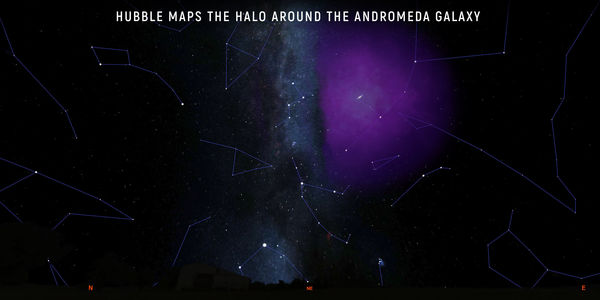
A team of scientists led by Notre Dame Research Professor Nicolas Lehner, and utilizing NASA’s Hubble Space Telescope, created a comprehensive map of the halo of plasma surrounding the Andromeda galaxy and discovered that it is already touching the halo of our own Milky Way.
The team’s findings, which appear in the August 27 edition of The Astrophysical Journal, show that the Andromeda galaxy reaches about halfway to the Milky Way (about 1.3 million light years) and in some directions extends for 2 million light years.
The study also revealed the halo has a layered structure comprised of two nested, distinct shells of gas.

“Understanding the huge halos of gas surrounding galaxies is immensely important,” explained Research Experience for Undergraduate summer student at Notre Dame Samantha Berek, of Yale University in New Haven, Connecticut. “This reservoir of gas contains fuel for future star formation within the galaxy, as well as outflows from events such as supernovae. It’s full of clues regarding the past and future evolution of the galaxy, and we’re finally able to study it in great detail in our closest galactic neighbor.”
“We find the inner shell that extends to about a half million light-years is far more complex and dynamic,” explained Lehner, an astrophysicist in the Department of Physics. “The outer shell is smoother and hotter. This difference is a likely result from the impact of supernova activity in the galaxy’s disk more directly affecting the inner halo.”
Lehner’s team found the halo to have significant quantities of heavy elements, which are birthed from stars as they explode and die. These heavy metals then migrate to the halo of the galaxy.
The program called Project AMIGA (Absorption Map of Ionized Gas in Andromeda) used the light from 43 quasars. The quasars, situated behind the halo, allowed scientists to study how their light is absorbed by the halo of Andromeda and how the light absorption changes across the halo. The halo of Andromeda is made of rarified and ionized gas, which doesn’t emit easily detectable radiation. Examining the absorption in the light coming from the quasars behind it is the most sensitive way to study the diffuse halo itself. Lehner’s team used Hubble’s Cosmic Origins Spectrograph to study ultraviolet (UV) light from the quasars. Because the UV light is absorbed by Earth’s atmosphere it can only be observed from beyond our atmosphere.
This is not the first time Lehner and the team of researchers have studied Andromeda’s halo. In 2015, they determined Andromeda’s halo was massive. Now, as a result of this new study, the halo has been mapped in more detail offering a better understanding of its size and mass.
“Previously, there was very little information—only six quasars—within 1 million light-years of the galaxy. This new program provides much more information on this inner region of Andromeda’s halo,” explained co-investigator J. Christopher Howk, professor in the Department of Physics at the University of Notre Dame. “Probing gas within this radius is important, as it represents something of a gravitational sphere of influence for Andromeda.”
Owing to our location in the Milky Way, scientists cannot easily determine the depth of our own galaxy’s halo. However, they believe the halos of Andromeda and the Milky Way must be very similar since these two galaxies are quite similar. The two galaxies are on a collision course, and will merge to form a giant elliptical galaxy beginning about 4 billion years from now.
Andromeda is the only galaxy in the universe for which this experiment can be done now, and only with Hubble. “This is truly a unique experiment because only with Andromeda do we have information on its halo along not only one or two sightlines, but over 40,” explained Lehner. “This is groundbreaking for capturing the complexity of a galaxy halo beyond our own Milky Way.”
Originally published by at science.nd.edu on August 28, 2020.